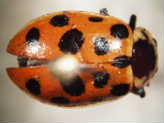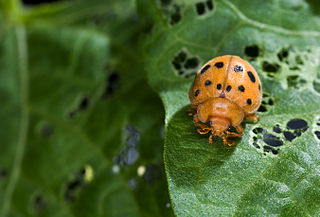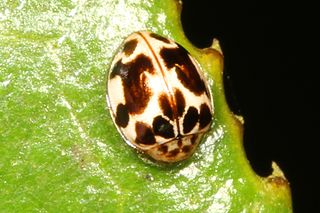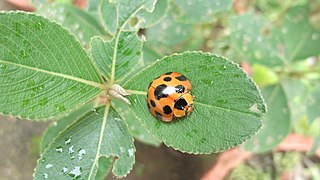
Hippodamia tredecimpunctata, commonly known as the thirteen-spot ladybeetle, is a species of lady beetle.

Coccinellidae is a widespread family of small beetles. They are commonly known as ladybugs in North America and ladybirds in the United Kingdom; "lady" refers to mother Mary. Entomologists use the names ladybird beetles or lady beetles to avoid confusion with true bugs. The more than 6,000 described species have a global distribution and are found in a variety of habitats. They are oval beetles with a domed back and flat underside. Many of the species have conspicuous aposematic (warning) colours and patterns, such as red with black spots, that warn potential predators that they taste bad.

Coleomegilla maculata, commonly known as the spotted lady beetle, pink spotted lady beetle or twelve-spotted lady beetle, is a large coccinellid beetle native to North America. The adults and larvae feed primarily on aphids and the species has been used as a biological control agent. Based on name connotation and to avoid confusion with other species also called "spotted ladybeetle", spotted pink ladybeetle is probably the most appropriate common name for this species.

Vibidia duodecimguttata is a species of ladybird beetle belonging to the family Coccinellidae, subfamily Coccinellinae.

The Epilachninae are a subfamily of the family of lady beetles, the Coccinellidae, in the order Coleoptera. Superficially, they look much like other ladybirds in the larger subfamily Coccinellinae, but they differ importantly in their biology, in that the members of the subfamily are largely or completely leaf-feeding herbivores rather than being predators. Accordingly, several members of the subfamily are crop pests, and sometimes cause locally serious crop losses.

Micraspis discolor is a species of ladybird. It was described by Johan Christian Fabricius in 1798. It is widespread throughout Asia, North America and parts of Oceania.

Brumoides suturalis, the three-striped lady-beetle, is a species of ladybird described by Johan Christian Fabricius in 1789. It is found in India, Pakistan, Bangladesh, Sri Lanka, Bhutan, Nepal, Indonesia, Philippines and Papua New Guinea.

Psyllobora vigintimaculata, the twenty-spotted lady beetle, is a species of lady beetle in the family Coccinellidae. It is found in North America.

Chilocorus nigritus, sometimes referred to as the Malaysian ladybird beetle, is a species of lady beetle in the family Coccinellidae. It is native to SE Asia, but has been introduced for use in biological pest control in Hawaii and many parts of the world, including Europe.

Cheilomenes sexmaculata is a species of ladybird. Although sometimes known by the common name of six-spotted zigzag ladybird, this is misleading as there are several colour morphs and some colour morphs of the species can be confused with Micraspis discolor and Chilocorus nigrita. The species has a wide distribution range within the Asian tropics and subtropical zones from India to Japan and parts of the Australian region. They have been introduced into the Caribbean islands as a biocontrol agent and their spread to South America was noted in 2019. It is well known as a predator of aphids and other small insects.

Harmonia octomaculata is a species of ladybird of the family Coccinellidae. It is found throughout India, Pakistan, Nepal, Bangladesh, Sri Lanka, Micronesia, and Australia.
Axinoscymnus puttarudriahi, is a species of lady beetle native to India and Sri Lanka.

Synonycha grandis, commonly known as Giant bamboo ladybird, is a species of lady beetle found in Australia, Oceania and Southern Asia.
Cryptogonus orbiculus, is a species of lady beetle found in India, Sri Lanka, Nepal, China, Taiwan, Japan, Thailand, Guam, and Northern Mariana Islands.
Pseudaspidimerus trinotatus, is a species of lady beetle found in India, Sri Lanka and Myanmar.

Scymnus (Scymnus) nubilus, is a species of lady beetle found in Pakistan, India, Bangladesh, Sri Lanka, Nepal, Myanmar, China, and Asia Minor.
Illeis (Hibachi) bistigmosa, is a species of lady beetle native to India, and Sri Lanka.
Megalocaria dilatata, is a species of lady beetle native to India, Sri Lanka and Bhutan.
Novius breviuscula is a species of lady beetle native to India, Sri Lanka and Myanmar.
Novius octoguttata is a species of lady beetle native to India, Sri Lanka, Pakistan, Myanmar and China.













